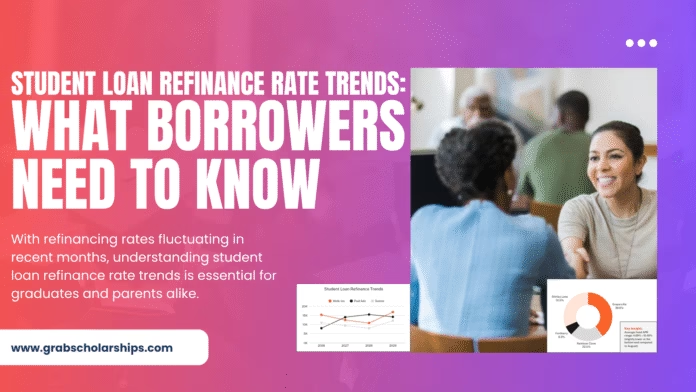Student loan refinancing continues to be one of the most talked-about financial strategies for borrowers who want to lower their debt burden. With refinancing rates fluctuating in recent months, understanding student loan refinance rate trends is essential for graduates and parents alike. Whether you’re looking for lower monthly payments, shorter loan terms, or reduced interest costs, staying updated on the latest refinance rate shifts can help you make informed decisions.
This in-depth guide explores the current refinance rates, recent trends, eligibility requirements, pros and cons, real-life examples, and actionable refinancing strategies. By the end, you’ll have a clear understanding of how refinancing works, what factors influence rates, and whether it’s the right move for your financial situation.
Key Takeaways
- Student loan refinance rates remain elevated in 2025, with fixed APRs averaging between 4.69% and 10.49%, while variable APRs range from 5.51% to 10.70%.
- Borrowers with excellent credit scores and low debt-to-income ratios qualify for the lowest rates.
- Refinancing can reduce interest costs, simplify payments, and remove co-signers, but it comes with the trade-off of losing federal protections and forgiveness programs.
- Market conditions, Federal Reserve decisions, and individual creditworthiness continue to shape refinance rate trends.
- Refinancing is not one-size-fits-all—borrowers must weigh eligibility, long-term financial goals, and alternatives before making a decision.
Current Student Loan Refinance Rates (September 2025)
According to U.S. News analysis of private lenders, refinancing rates in August and September 2025 showed little change compared to the previous month:
- Average fixed APR range: 4.69% – 10.49% (slightly lower at the bottom end compared to August).
- Average variable APR range: 5.51% – 10.70% (up marginally on the higher end).
What this means for borrowers:
- Borrowers with excellent credit (740+ FICO score) and strong financial profiles qualify for rates at the lower end of the range.
- Borrowers with fair credit, higher debt, or inconsistent income face rates closer to the upper end.
Trend analysis:
- Over the past year, variable rates have risen more aggressively than fixed rates, reflecting broader market rate hikes.
- Lenders remain cautious, pricing in inflation concerns and borrower default risks.
What Does Refinancing a Student Loan Mean?
When you refinance a student loan, a private lender pays off your existing loans and issues a new loan with updated terms. These terms depend largely on:
- Your creditworthiness
- Your income and employment stability
- Your debt-to-income (DTI) ratio
Example Scenario
- Original loan: $40,000 in federal loans at an average 6.5% interest.
- Refinanced loan: New 10-year loan at 4.8% fixed interest.
Impact: Monthly payments drop by about $60, and total lifetime interest savings reach nearly $7,000.
However, the borrower loses access to federal forgiveness programs and income-driven repayment plans. This trade-off highlights why refinancing decisions should be based on personal financial circumstances.
Pros and Cons of Student Loan Refinancing
Advantages
- Lower interest rates → Reduce lifetime interest costs.
- Simplified repayment → Combine multiple loans into one monthly payment.
- Shorter payoff period → Pay off loans faster if you opt for shorter terms.
- Co-signer release → Take full financial responsibility and free your co-signer.
Disadvantages
- Loss of federal benefits → No access to loan forgiveness or income-driven repayment.
- Stricter eligibility → Requires good to excellent credit and steady income.
- Potential higher payments → Choosing shorter repayment terms may increase monthly burden.
- Variable rate risk → Rates may rise significantly over time.
Who Is Eligible for Student Loan Refinancing?
Eligibility requirements vary by lender, but most look for:
- Minimum Credit Score: Usually mid-600s or higher. For the best rates, aim for 740+.
- Stable Income: Proof of consistent income, often with minimum annual thresholds (e.g., $40,000+).
- Debt-to-Income Ratio (DTI): Ideally below 40%.
- Completed Degree: Many lenders require borrowers to have graduated.
- Residency: Must reside in a state where the lender operates.
Tip: If you don’t meet these requirements, you may still qualify with a creditworthy co-signer.
Student Loan Refinance Rate Trends: Why Rates Are Moving
Refinance rates don’t exist in isolation—they reflect broader economic and financial market conditions. Here’s what drives them:
- Federal Reserve rate policy: Higher Fed rates push private lenders to increase borrowing costs.
- Inflation outlook: Rising inflation leads to higher long-term fixed rates.
- Lender competition: More lenders in the market can help drive rates down for qualified borrowers.
- Credit market risk: During economic slowdowns, lenders tighten standards and raise rates.
2025 Outlook: Rates are expected to stay relatively high into mid-2026 unless inflation significantly cools. Borrowers should prepare for steady or slightly rising rates in the short term.
How to Refinance Student Loans: Step-by-Step
If refinancing fits your goals, here’s the process:
- Check your credit score and clean up errors.
- Review current loan terms and calculate your break-even point.
- Get prequalified with multiple lenders for soft-credit estimates.
- Compare repayment terms and APRs, not just monthly payments.
- Apply formally with your chosen lender.
- Continue payments until refinancing is finalized.
Real-Life Refinance Examples
Case 1: Graduate with Excellent Credit
- Loan balance: $60,000
- Original APR: 6.8%
- Refinanced APR: 4.2% fixed for 10 years
- Savings: $9,500 in interest
Case 2: Parent PLUS Loan Refinance
- Loan balance: $30,000
- Original APR: 7.2%
- Refinanced APR: 5.3% fixed for 15 years
- Impact: Monthly payment drops by $110, but total interest costs rise slightly.
Case 3: Borrower with Co-Signer
- Loan balance: $45,000
- Credit score: 650
- APR with co-signer: 5.8% fixed (vs. 8.2% without co-signer)
- Impact: Co-signer helps borrower save $6,800 in interest.
Alternatives to Refinancing
Before refinancing, consider other strategies:
- Income-driven repayment plans (federal loans only).
- Federal loan consolidation for simplified payments.
- Co-signer release options with your current lender.
- Extra monthly payments toward principal to pay debt faster.
- Financial hardship programs (forbearance or deferment).
How to Choose the Best Refinance Lender
When evaluating lenders, look at:
- APR ranges (fixed vs. variable).
- Repayment term options (5–25 years).
- Autopay discounts (commonly 0.25%).
- Hardship protections (forbearance, deferment).
- Loan minimums/maximums (important for high balances).
- Customer service reputation.
Strategies to Improve Your Refinance Approval Odds
- Boost your credit score: Pay bills on time, reduce balances.
- Lower your DTI: Pay down other debts before applying.
- Show consistent income: Stay employed or provide proof of long-term contracts.
- Consider a co-signer: Especially useful for young professionals.
- Shop around: Different lenders weigh criteria differently.
Refinancing student loans in 2025 can be a smart move for borrowers with strong credit profiles and stable income. However, it’s not for everyone—especially those relying on federal loan protections or forgiveness programs.
If you:
- Have excellent credit
- Don’t plan to use federal repayment benefits
- Want to lower interest costs or simplify payments
…then refinancing may be worth pursuing today.
But if you’re uncertain about job stability, rely on federal relief options, or have low credit, it may be wise to wait or explore alternatives.
Are you considering refinancing your student loans? Take the first step today by:
- Checking your credit score to see where you stand.
- Comparing rates from multiple lenders—never settle for the first offer.
- Using a student loan refinance calculator to understand your potential savings.
Smart refinancing decisions start with informed action. Begin exploring your options now to take control of your student debt and secure a stronger financial future.




